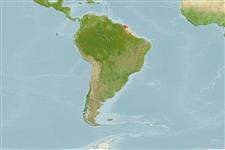Teleostei (teleosts) >
Gobiiformes (Gobies) >
Gobiidae (Gobies) > Gobiinae
Etymology: Akko: Greek, akko, -oys = bogeyman, ugly devil (used to frighten children) (Ref. 45335).
More on authors: Birdsong & Robins.
Environment: milieu / climate zone / depth range / distribution range
Ecology
Marine; demersal; depth range ? - 20 m (Ref. 58018). Tropical
Southwest Atlantic: Brazil.
Size / Weight / Age
Maturity: Lm ? range ? - ? cm
Max length : 8.1 cm SL male/unsexed; (Ref. 34010)
Short description
Identification keys | Morphology | Morphometrics
Distinguished by the following characteristics: very small eyes; light pink body color with darker red areas composed of blood capillaries close to surface; elongate body; first dorsal with VII spines; upper and lower jaws with enlarged, widely spaced teeth that overlap the lips of both jaws; greatly reduced head pores, occasionally absent (Ref. 92840).
Inhabits muddy bottom. Apparently feeds mainly on calanoid copepods (Ref. 34010).
Life cycle and mating behavior
Maturity | Reproduction | Spawning | Eggs | Fecundity | Larvae
Birdsong, R.S. and C.R. Robins, 1995. New genus and species of seven-spined goby (Gobiidae: Gobiosomini) from the offing of the Amazon River, Brazil. Copeia 1995(3):676-683. (Ref. 34010)
IUCN Red List Status (Ref. 130435: Version 2024-1)
Threat to humans
Harmless
Human uses
Tools
Special reports
Download XML
Internet sources
Estimates based on models
Phylogenetic diversity index (Ref.
82804): PD
50 = 0.6250 [Uniqueness, from 0.5 = low to 2.0 = high].
Bayesian length-weight: a=0.00955 (0.00355 - 0.02566), b=3.03 (2.80 - 3.26), in cm total length, based on LWR estimates for this (Sub)family-body shape (Ref.
93245).
Trophic level (Ref.
69278): 3.0 ±0.00 se; based on food items.
Resilience (Ref.
120179): High, minimum population doubling time less than 15 months (Preliminary K or Fecundity.).
Fishing Vulnerability (Ref.
59153): Low vulnerability (10 of 100).
